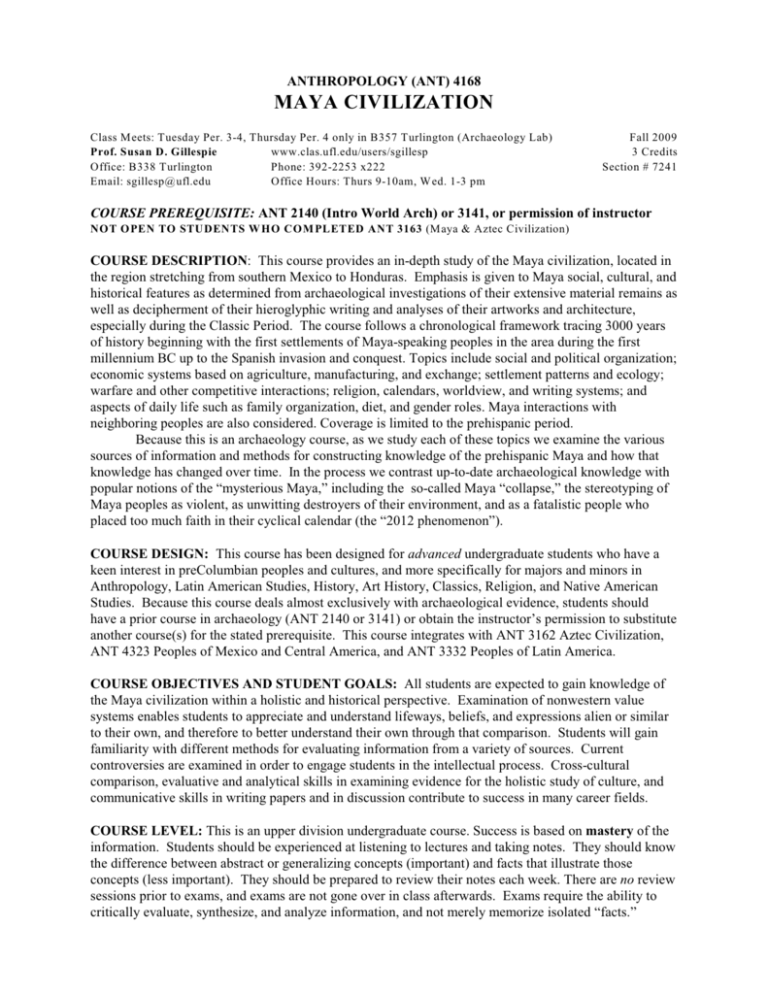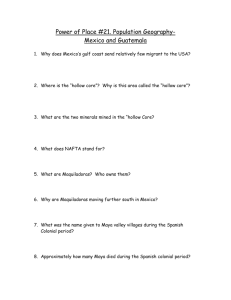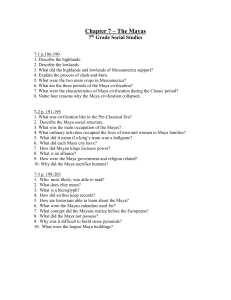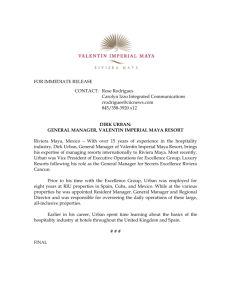
ANTHROPOLOGY (ANT) 4168
MAYA CIVILIZATION
Class Meets: Tuesday Per. 3-4, Thursday Per. 4 only in B357 Turlington (Archaeology Lab)
Prof. Susan D. Gillespie
www.clas.ufl.edu/users/sgillesp
Office: B338 Turlington
Phone: 392-2253 x222
Email: sgillesp@ufl.edu
Office Hours: Thurs 9-10am, W ed. 1-3 pm
Fall 2009
3 Credits
Section # 7241
COURSE PREREQUISITE: ANT 2140 (Intro World Arch) or 3141, or permission of instructor
NOT OPEN TO STUDENTS W HO COM PLETED ANT 3163 (Maya & Aztec Civilization)
COURSE DESCRIPTION: This course provides an in-depth study of the Maya civilization, located in
the region stretching from southern Mexico to Honduras. Emphasis is given to Maya social, cultural, and
historical features as determined from archaeological investigations of their extensive material remains as
well as decipherment of their hieroglyphic writing and analyses of their artworks and architecture,
especially during the Classic Period. The course follows a chronological framework tracing 3000 years
of history beginning with the first settlements of Maya-speaking peoples in the area during the first
millennium BC up to the Spanish invasion and conquest. Topics include social and political organization;
economic systems based on agriculture, manufacturing, and exchange; settlement patterns and ecology;
warfare and other competitive interactions; religion, calendars, worldview, and writing systems; and
aspects of daily life such as family organization, diet, and gender roles. Maya interactions with
neighboring peoples are also considered. Coverage is limited to the prehispanic period.
Because this is an archaeology course, as we study each of these topics we examine the various
sources of information and methods for constructing knowledge of the prehispanic Maya and how that
knowledge has changed over time. In the process we contrast up-to-date archaeological knowledge with
popular notions of the “mysterious Maya,” including the so-called Maya “collapse,” the stereotyping of
Maya peoples as violent, as unwitting destroyers of their environment, and as a fatalistic people who
placed too much faith in their cyclical calendar (the “2012 phenomenon”).
COURSE DESIGN: This course has been designed for advanced undergraduate students who have a
keen interest in preColumbian peoples and cultures, and more specifically for majors and minors in
Anthropology, Latin American Studies, History, Art History, Classics, Religion, and Native American
Studies. Because this course deals almost exclusively with archaeological evidence, students should
have a prior course in archaeology (ANT 2140 or 3141) or obtain the instructor’s permission to substitute
another course(s) for the stated prerequisite. This course integrates with ANT 3162 Aztec Civilization,
ANT 4323 Peoples of Mexico and Central America, and ANT 3332 Peoples of Latin America.
COURSE OBJECTIVES AND STUDENT GOALS: All students are expected to gain knowledge of
the Maya civilization within a holistic and historical perspective. Examination of nonwestern value
systems enables students to appreciate and understand lifeways, beliefs, and expressions alien or similar
to their own, and therefore to better understand their own through that comparison. Students will gain
familiarity with different methods for evaluating information from a variety of sources. Current
controversies are examined in order to engage students in the intellectual process. Cross-cultural
comparison, evaluative and analytical skills in examining evidence for the holistic study of culture, and
communicative skills in writing papers and in discussion contribute to success in many career fields.
COURSE LEVEL: This is an upper division undergraduate course. Success is based on mastery of the
information. Students should be experienced at listening to lectures and taking notes. They should know
the difference between abstract or generalizing concepts (important) and facts that illustrate those
concepts (less important). They should be prepared to review their notes each week. There are no review
sessions prior to exams, and exams are not gone over in class afterwards. Exams require the ability to
critically evaluate, synthesize, and analyze information, and not merely memorize isolated “facts.”
REQUIRED READINGS: The two required textbooks available at the book stores are:
1) Ancient Maya: The Rise and Fall of a Rainforest Civilization (2004) by Arthur Demarest
2) Reading the Past: Maya Glyphs (1989) by Stephen Houston
These books are also on reserve in the library, as are many other books that may be of use. Additional
readings are posted on the E-Learning site by week. Assigned readings should be done each week.
E-LEARNING COMPONENT: Go to http://lss.at.ufl.edu. Log in with your Gator-link ID. If you
haven’t used E-Learning before, run the tutorial. All lecture outlines, assignments, and extra readings
are posted here. Every student is expected to download the lecture outline, print it out (you can add
additional spacing if you wish), and bring it to class. The outlines do not provide the entire lecture, but
they show the organization of major and subsidiary points and have all the important proper names and
technical terms. Check the website regularly for announcements and added handouts and readings.
FORMAT: The course format is lecture. A 10-minute break is called on Tuesdays between lectures.
Students are strongly encouraged to ask the professor questions at any time during the lectures, both to
clarify what was said in class or in the readings, and to raise related issues. To supplement classroom
face-time, students may submit thoughtful written questions (by email) to the professor and can earn up
to 10 points of Extra Credit during the semester for doing so, 1 point per week.
ASSIGNED SEATING: At the 5th class meeting a seating chart will be distributed. On that day you
may choose where to sit, and this will become your assigned seat–you should always sit there. Put your
seat number on your papers to facilitate returning them to you. Seat number is also required on exams.
ATTENDANCE POLICY: Most of the course material is presented only in the lectures, which are
supplemented with powerpoint presentations. There is a high visual component to the study of the Maya
civilization. Maya studies are in a volatile state, and only in the lectures will students receive updated
information. Since class meetings provide the only opportunity to “download” the lecture, attendance is
not optional. If you miss any class, it is your responsibility to obtain the lecture notes from a classmate.
PERSONAL DEVICES: All portable electronic devices must be turned off and stowed away.
Notebook computers are allowed only for taking notes; any other use is prohibited. Newspapers and
other reading materials not relevant to the class should be out of sight by the time class begins.
EXAMS: Your grade in this class is based primarily on your mastery of the course material as
demonstrated on the exams, which cover lectures, readings, and visual information from slides and maps.
Exams consist of objective, identification, and short essay questions.
Exam I
75 points
25% of the final grade
Exam II
75 points
25%
Exam III
75 points
25%
Missed Exams may be made up ONLY if you have a valid excuse for an involuntary absence during the
scheduled exam period AND if you (or someone on your behalf) has informed the Professor before the
exam begins that you have a valid excuse. Missed exams should be made up within one week of the
original exam period at the professor’s convenience.
ADDITIONAL ASSIGNMENTS: The remaining 25% of the final grade is based on four additional
assignments: a timeline (3%), a map quiz (7% ), a midterm project (5%), and a final powerpoint project
(10%). The assignments are posted on the E-learning website. Every student is expected to do
independent work. No credit will be given if there is evidence of collaboration or plagiarism, including
unauthorized or unattributed use of internet sources (see below on plagiarism). E-mailed projects and
those with many errors will not be graded. Late projects are severely penalized.
2
ADDITIONAL RESOURCES: The E-learning website has additional documents, including maps, a
guide to hieroglyphs, and guide to well known royal dynasties. Links to useful websites with credible
Maya research and images are also available there. Books on Maya writing and kingship are on reserve
in the library. These resources are needed for the map quiz and to complete the other assignments.
GRADES: All grades in this course are earned throughout the semester, not negotiated individually at
the end of the semester. Grading is based on mastery of the course material as determined from the
exams and other assignments. Letter grades are assigned at the end of the semester, based on a total of
300 points, according to the grading scale below. The gradebook is “closed” at the date of the
scheduled final exam for the class; any overdue work must be turned in by that date. For University
policy on grades see http://www.registrar.ufl.edu/catalog/policies/regulationgrades.html
A
A-
B+
B
B-
C+
C
C-
D+
D
D-
E
270300
264269
255263
240254
234239
225233
210224
204209
195203
180194
174179
173 or
lower
4.00
3.67
3.33
3.00
2.67
2.33
2.00
1.67
1.33
1.00
.67
0.00
Federal privacy regulations prohibit the release of scores and grades over the phone or by e-mail.
COPYRIGHT INFORMATION: Lectures may not be tape-recorded without the prior express written
permission of Susan D. Gillespie. The syllabus, lectures, lecture outlines, and handouts for this course
are copyrighted, intended for the private use of students registered in ANT 4168. They cannot legally be
reproduced, in part or in whole, by any commercial enterprise or for any commercial purposes.
STRATEGIES FOR SUCCESS (OR, How to Avoid Failure):
Every student is expected to:
Learn the Maya words, especially place names. Practice pronouncing them. Students who
become familiar with the words tend to remember the material better than those who do not.
Use the lecture outlines to help you differentiate major from minor points of information, and to
see how subsidiary information (1a, 1b, etc.) supports the major points (A, B, etc.). To study for exams
make sure you can explain the 3-4 major ideas with supporting information for any single lecture.
Learn the maps and time charts. Knowing where places are located in space and time helps you
to understand the course material. There will be a map quiz early in the semester.
Make time to do the reading assignments and review your notes every week. This is the most
effective way to learn. Cramming right before the exam is a strategy for failure.
Ask for help if you need assistance in taking notes, comprehending the readings, or studying for
the exams. If you cannot come during office hours, make an appointment for a more convenient time.
ACCEPTANCE OF COURSE REQUIREMENTS: By remaining registered in this class, you agree to
accept the course requirements and expectations as stated in this syllabus. These are in addition to other
general University requirements and codes of conduct as stated in official documents.
All students must fill out and sign the questionnaire on the last page of the syllabus and return it
to the Professor before the day of the first exam. This is a course requirement.
3
TENTATIVE SCHEDULE OF TOPICS AND READINGS–subject to change
On Tuesdays (double-lecture) there are two separate lecture outlines.
1
2
3
4
5
6
7
8
9
Date
Topic
Textbook
Other Assignments (on E-Learning)
8/25
Introduction
W ho W ere the Maya?
Chapter 1
Maya Pronunciation Guide
Orthography (from W ho’s W ho)
Hervik - “The Mysterious Maya of
National Geographic”
8/27
Discovering the Maya
Chapter 3
9/1
Sources of Information
Theories and Themes
Chap. 2, pp. 20-30
9/3
Mesoamerican Geography
and Culture History
Chap. 2, pp. 8-20
Timeline Assigned
Maps (study for quiz) in map folder
9/8
Mesoamerican Cosmology
Mesoamerican Cosmogony
Ch 8, pp.175-193
Gossen - “Temporal and Spatial
Equivalents in Chamula”
9/10
Mesoamerican Calendars
Ch. 8 pp. 193-196
Tim eline Due
Calvin Calendar Pages
9/15
Origins to Early Preclassic
Middle Preclassic Developments
Ch 4. pp.53-72
9/17
M AP QUIZ + video
9/22
Late Preclassic Developments
Highlands and Lowlands
Ch 4 pp. 72-end
Cival newspaper story
9/24
Long Count Calendar
Ch. 8 pp. 196-201
Place notation handout
Calvin Long Count symbols
European-Maya Correlation handout
9/29
EXAM I
10/1
NO CLASS M EETING
10/6
Maya Video
10/8
Intro: Maya Hieroglyphic W riting
Houston Ch. 1
San Bartolo Science article
10/13
Video: “Cracking the Maya Code”
Advanced Aspects of W riting
Houston Ch. 2-5
10/15
Ecology and Subsistence
Ch. 6 pp. 120-end
10/20
Settlement Patterns
Early Classic Divine Kingship
Ch. 6 pp 113-120
Ch. 5
10/22
The Teotihuacan Connection?
Braswell “Reinterpreting Early
Classic Interaction”
Midterm Project Due
4
10
11
12
13
14
15
16
10/27
Social Organization
Daily and Courtly Life
Gillespie - “Rethinking Maya Social
Organization”
Miller and Martin - “Life at the Maya
Court”
10/29
Gender Roles and Representations
Joyce - “Gender in Classic Maya
Monuments”
11/3
EXAM II
11/5
Political Organization
Ch. 8 pp. 201-207
11/10
State Political Cults
Economy: Manufacture and Trade
Ch. 9 to p. 225
Ch. 7
11/12
W arfare: Conquest and Sacrifice
Ch 9 pp. 226-235
11/17
W arfare: Annihilation
Late Classic in Northern Lowlands
Ch. 10 pp. 249-260
Ch. 9 pp. 235-239
11/19
Developments in Puuc Region
Ch. 10 pp. 268-271
11/24
9 th Century Epiclassic Connections
Collapse or Transformation?
Ch. 10 pp. 240249, 260-268
Chase and Chase - “Transformations
in Classic to Postclassic Maya
Society”
11/26
NO CLASS – THANKSGIVING
12/1
The Toltec Problem
Chichen Itza: the cult of Tollan
Ch. 10 pp. 271-276
Gillespie - “Toltecs, Tula and Chichen
Itza”
12/3
Postclassic Yucatan and
Guatemalan Highlands
Ch 11 and 12
12/8
EXAM III
12/14
FINAL PROJECT DUE
by 12:30 (via E-Learning)
Potter and King: “Heterarchical
Approaches to Lowland Maya
Socioeconomics”
The following information is included in conformance with University Policy:
1) Students seeking modification of due dates for assignments and exams for religious reasons (e.g., holiday
observance) should feel free to contact the Professor and request this modification.
2) Students seeking any classroom accommodation to facilitate their education must first register with the Dean of
Students Office. The Dean of Students Office will provide documentation to the student, who must then provide this
documentation to the Professor when requesting accommodation.
3) The University reminds every student of the implied pledge of Academic Honesty: on any work submitted for
credit the student has neither received nor given unauthorized aid. This refers to cheating , plagiarism, and
unattributed or under-attributed use of internet sources. Students should consult the Student Guide at
www.dso.ufl.edu/stg/ for information.
© 2009 Susan D. Gillespie - All Rights Reserved
5
ANT 4168
Fall 2009
Please complete and return to this page to the Professor as soon as possible and no later than the meeting
day before the first exam. This is a course requirement for ANT 4168. This information is kept
confidential. It is used to correct the class roster and to help the professor assist students and
accommodate their interests, wherever possible.
Name: _____________________________________________________________________________
Preferred nickname?: _______________________________________________
Local Phone #: _______________________________________
LEGIBLY PRINT your primary Email address: _____________________________________________
Year in school: ________________________________________
Academic Major: ______________________________________
List titles of prior anthropology courses you have taken:
____________________________________________________________________________________
____________________________________________________________________________________
____________________________________________________________________________________
____________________________________________________________________________________
Please state your interest, whatever it might be, in taking this class:
____________________________________________________________________________________
____________________________________________________________________________________
____________________________________________________________________________________
____________________________________________________________________________________
___________________________________________________________________________________
Please sign here to indicate that you have read this syllabus and accept the stated course requirements:
___________________________________________ (signature)
6








